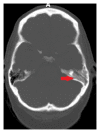A Case of Transient, Isolated Cranial Nerve VI Palsy due to Skull Base Osteomyelitis
- PMID: 25045551
- PMCID: PMC4082859
- DOI: 10.1155/2014/369867
A Case of Transient, Isolated Cranial Nerve VI Palsy due to Skull Base Osteomyelitis
Abstract
Otitis externa affects both children and adults. It is often treated with topical antibiotics, with good clinical outcomes. When a patient fails to respond to the treatment, otitis externa can progress to malignant otitis externa. The common symptoms of skull bone osteomyelitis include ear ache, facial pain, and cranial nerve palsies. However, an isolated cranial nerve is rare. Herein, we report a case of 54-year-old female who presented with left cranial nerve VI palsy due to skull base osteomyelitis which responded to antibiotic therapy.
Figures




Similar articles
-
Central skull base osteomyelitis secondary to invasive aspergillus sphenoid sinusitis presenting with isolated 12th nerve palsy.IDCases. 2020 Aug 11;22:e00930. doi: 10.1016/j.idcr.2020.e00930. eCollection 2020. IDCases. 2020. PMID: 32923366 Free PMC article.
-
Multiple cranial nerve palsies in malignant external otitis: A rare presentation of a rare condition.IDCases. 2020 Sep 5;22:e00945. doi: 10.1016/j.idcr.2020.e00945. eCollection 2020. IDCases. 2020. PMID: 32983891 Free PMC article.
-
Extensive Skull Base Osteomyelitis Secondary to Malignant Otitis Externa.J Int Adv Otol. 2019 Dec;15(3):463-465. doi: 10.5152/iao.2019.5406. J Int Adv Otol. 2019. PMID: 30924772 Free PMC article.
-
An emergency medicine-focused review of malignant otitis externa.Am J Emerg Med. 2020 Aug;38(8):1671-1678. doi: 10.1016/j.ajem.2020.04.083. Epub 2020 Apr 29. Am J Emerg Med. 2020. PMID: 32505469 Review.
-
Malignant otitis externa: An updated review.Am J Otolaryngol. 2021 Mar-Apr;42(2):102894. doi: 10.1016/j.amjoto.2020.102894. Epub 2021 Jan 5. Am J Otolaryngol. 2021. PMID: 33429178 Review.
Cited by
-
Isolated Abducens Nerve Palsy in the Setting of Isolated Sphenoid Sinusitis: A Case Report.Cureus. 2023 Oct 13;15(10):e46993. doi: 10.7759/cureus.46993. eCollection 2023 Oct. Cureus. 2023. PMID: 38022164 Free PMC article.
-
Rare case of a 3-year-old with Candida skull base osteomyelitis: lessons to be learnt.BMJ Case Rep. 2019 Apr 8;12(4):e228026. doi: 10.1136/bcr-2018-228026. BMJ Case Rep. 2019. PMID: 30967448 Free PMC article.
-
Tuberculous Skull Base Osteomyelitis With Cerebral Venous Sinus Thrombosis in an Immunocompetent Adolescent: A Case Report.Cureus. 2022 Apr 6;14(4):e23865. doi: 10.7759/cureus.23865. eCollection 2022 Apr. Cureus. 2022. PMID: 35530851 Free PMC article.
-
Cranial nerve palsy prevalence and associated factors in patients with malignant otitis externa.Laryngoscope Investig Otolaryngol. 2023 Mar 2;8(2):538-545. doi: 10.1002/lio2.1035. eCollection 2023 Apr. Laryngoscope Investig Otolaryngol. 2023. PMID: 37090887 Free PMC article.
References
-
- Carfrae MJ, Kesser BW. Malignant otitis externa. Otolaryngologic Clinics of North America. 2008;41(3):537–549. - PubMed
-
- Meltzer PE, Kelemen G. Pyocyaneous osteomyelitis of the temporal bone, mandible and zygoma. The Laryngoscope. 1959;69(10):1300–1316.
-
- Blyth CC, Gomes L, Sorrell TC, da Cruz M, Sud A, Chen SC-A. Skull-base osteomyelitis: fungal vs. bacterial infection. Clinical Microbiology and Infection. 2011;17(2):306–311. - PubMed
-
- Mani N, Sudhoff H, Rajagopal S, Moffat D, Axon PR. Cranial nerve involvement in malignant external otitis: implications for clinical outcome. The Laryngoscope. 2007;117(5):907–910. - PubMed
-
- Mak JC, Kim LH, Ong LTC, Bui TM. Acute abducens nerve palsy and weight loss due to skull base osteomyelitis. Medical Journal of Australia. 2010;192(12):719–720. - PubMed
LinkOut - more resources
Full Text Sources
Other Literature Sources

